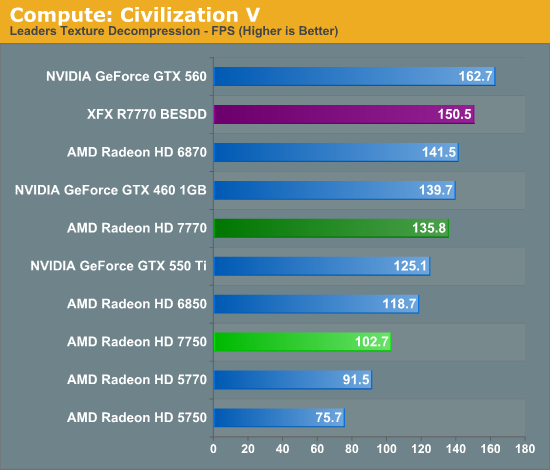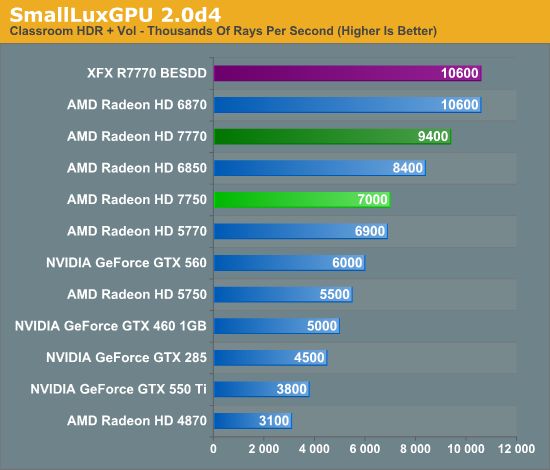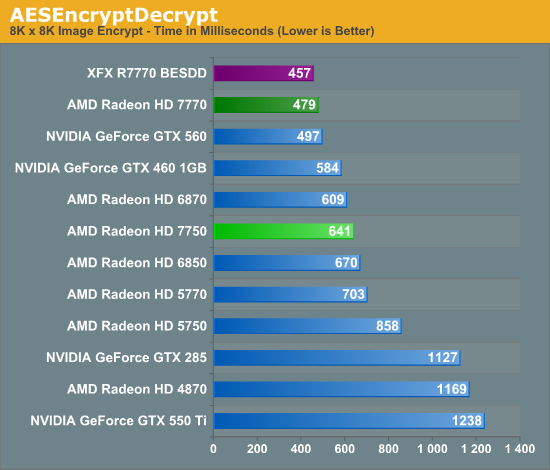AMD Radeon HD 7750 & Radeon HD 7770 GHz Edition Review: Evading The Price/Performance Curve
by Ryan Smith & Ganesh T S on February 15, 2012 12:01 AM EST- Posted in
- GPUs
- AMD
- HTPC
- GCN
- Radeon HD 7000
Compute Performance
Moving on from our look at gaming performance, we have our customary look at compute performance. With GCN AMD significantly overhauled their architecture in order to improve compute performance, as their long-run initiatives rely on GPU compute performance becoming far more important than it is today.
With such a move however AMD has to solve the chicken and the egg problem on their own, in this case by improving compute performance before there are really a large variety of applications ready to take advantage of it. As we’ll see AMD has certainly achieved that goal, but it raises the question of what was the tradeoff for that? We have some evidence that GCN is more efficient than VLIW5 on a per-shader basis even in games, but at the same time we can’t forget that AMD has gone from 800 SPs to 640 SPs in the move from Juniper to Cape Verde, in spite of a full node jump in fabrication technology. In the long run AMD will be better off, but I suspect we’re looking at that tradeoff today with the 7700 series.
Our first compute benchmark comes from Civilization V, which uses DirectCompute to decompress textures on the fly. Civ V includes a sub-benchmark that exclusively tests the speed of their texture decompression algorithm by repeatedly decompressing the textures required for one of the game’s leader scenes. Note that this is a DX11 DirectCompute benchmark.

Theoretically the 5770 has a 5% compute performance advantage over the 7770. In practice the 5770 doesn’t stand a chance. Even the much, much slower 7750 is ahead by 12%, meanwhile the 7770 is in a class of its own, competing with the likes of the 6870. The 7770 series still trails the GTX 560 to some degree, but once again we’re looking at the proof of just how much the GCN architecture has improved AMD’s compute performance.
Our next benchmark is SmallLuxGPU, the GPU ray tracing branch of the open source LuxRender renderer. We’re now using a development build from the version 2.0 branch, and we’ve moved on to a more complex scene that hopefully will provide a greater challenge to our GPUs.

SmallLuxGPU is another good showing for the GCN based 7700 series, with the 7770 once again moving well up the charts. This time it’s between the 6850 and 6870, and well, well ahead of the GTX 560 or any other NVIDIA video cards. Throwing in an overclock pushes things even farther, leading to the XFX BESDD tying the 6870 in this benchmark.
For our next benchmark we’re looking at AESEncryptDecrypt, an OpenCL AES encryption routine that AES encrypts/decrypts an 8K x 8K pixel square image file. The results of this benchmark are the average time to encrypt the image over a number of iterations of the AES cypher.

Under our AESEncryptDecrypt benchmark the 7770 does even better yet, this time taking the #2 spot and only losing to its overclocked self. PCIe 3.0 helps here, but as we’ve seen with the 7900 series there’s no replacement for a good compute architecture.
Finally, our last benchmark is once again looking at compute shader performance, this time through the Fluid simulation sample in the DirectX SDK. This program simulates the motion and interactions of a 16k particle fluid using a compute shader, with a choice of several different algorithms. In this case we’re using an (O)n^2 nearest neighbor method that is optimized by using shared memory to cache data.

It would appear we’ve saved the best for last, as in our fluid simulation benchmark the top three cards are all 7700 series cards. This benchmark strongly favors a well organized cache, leading to the 7700 series blowing past the 6800 series and never looking back. Even NVIDIA’s Fermi based video cards can’t keep up.










155 Comments
View All Comments
anactoraaron - Wednesday, February 15, 2012 - link
What happened there at 1920x1200 for the 6870? 23.2 fps seems a bit off to me. I get a solid 60 just about everywhere (occasional dips to ~50) at 1080.I am so glad I bought a 6870 ICEQ a month ago. Got the email today that I will be getting my rebate so your point about getting a 6870 for 159 AR is absolutely true. And the ICEQ edition I have is rocking a 1000/1150 oc all day long 32c idle 69c load via furmark 15 min run. Best part is it's much quieter than a reference card.
All of the 7xxx releases seem a bit lackluster to me.
Ryan Smith - Wednesday, February 15, 2012 - link
I go over this a bit in the commentary for that benchmark, but basically the 1GB cards are running out of memory in that benchmark. For reasons I've yet to determine, even though the 7700 series cards still only have 1GB they are handling the situation better than the 6800 and 5700.bazinga77 - Wednesday, February 15, 2012 - link
first thing that should be pointed out is that i believe that the 7700 series cards that launched today only have a 128 bit memory interface so no one should expect miracles especially at higher resolutions. the memory bandwidth on x700 cards and lower has always held them back a little, where as nvidia for instance on their 550ti uses a 192 bit memory interface. if this card used a higher bandwidth memory it would do better. also the 79xx series from amd upped the bandwidth from the 69xx series from 256 bit to 384 bit which is probably one of the reasons it was so impressive.well the gtx 460 is starting to disappear and amd discontinued the 6850 and 6870 two months ago so once they are gone they are gone. this is directly from amd. so i think this card fits in nicely and i expect once the 7850 launches that the price of this card will drop. i think that the 7770 almost being as fast as the 6850 isn't all that bad, especially because of how cool it runs and it seems like the factory oc cards close that gap even closer. considering how much power some of these cards took a couple of generations ago it seems like we are making progress. once the 7850 launches, which i believe happens next month, i think it will be the card to get, just as the 6850 was.
so all in all it seems like the 7770 will fit in nicely with a small price drop and and the discontinuation of some of the older amd and nvidia cards that has been happening, let alone taking into account the promotions we might see with rebates on these cards or bundled games etc.
lastly the 7750 seems like it will now be the best card on the market that doesn't require an external power connector and it will come in at only about $10 more than the current champ in that arena. so it looks like a nice card for the casual gamer or someone looking for an htpc card and it looks like the encoding features of the 77xx cards are pretty great.
chizow - Wednesday, February 15, 2012 - link
Like I said in the 7970 and 7950 review comments, the reality of the situation is only going to get worst as AMD reveals the rest of their 7-series product stack.Ryan I can tell you're doing your best not to be too hard on AMD but there comes a time we need to call a spade a spade. What AMD is doing here in terms of price and performance with the 7-series is easily the worst we've ever seen in the last decade from a new GPU architecture, especially considering they're also on a new process node.
If/when Nvidia pulls an RV770 on AMD, I really hope you and the rest of the media is up to the task the same way they were with the GTX 280. I don't think you were head GPU editor at that time but I'm sure you remember the backlash.
jjj - Wednesday, February 15, 2012 - link
So AMD either went stupid all of the sudden or they just can't produce enough cards yet and priced them to not sell.Either way,this is a mistake and they are only hurting their image (something they can't afford since Nvidia is still the stronger brand).Lets hope Nvidia wants market share and gives us something exciting soon.
stolid - Wednesday, February 15, 2012 - link
Arg. Might as well hang on to my 5770's. :/adonn78 - Wednesday, February 15, 2012 - link
And these cards are supossed to be an upgrade over the 6000 series how?Targon - Wednesday, February 15, 2012 - link
There is still a 7800 series set of cards that we have not seen yet. We saw the 7900 cards, and now the 7700 series. The comparisons here are 7700 vs. 6800 series, and that is ONE issue.Price vs. performance is the primary issue that I can see, and TIME will hopefully bring down the prices to a reasonable level. I also hope/expect that there are reasons for the prices that will be fixed quickly, so will reduce the prices. We shall see, but if NVIDIA is having problems, it may be that AMD is giving NVIDIA a chance to come back, and is saving their next big performance jump for that release.
chizow - Wednesday, February 15, 2012 - link
"Price vs. performance is the primary issue that I can see, and TIME will hopefully bring down the prices to a reasonable level."But that's exactly the problem, time hasn't brought price down to a reasonable level because we've already had 14+ months of this performance level at the same or better prices. AMD's pricing does nothing to shift the price performance metric and if anything, they are actually falling behind the curve a bit as you can get "old" parts that perform the same or better than these "new" ones at much lower prices.
The 7800 series will only emphasize this point further with similar performance relative to the 6900 series, but at much worst prices. But that's the trickle down effect of pricing a new "high-end" flagship part that's only 15-25% faster than the last-gen at a 10% price hike. There just isn't much value derived as you go further down the ladder.
ET - Wednesday, February 15, 2012 - link
This is disappointing, although I agree that the 7750 does have a place due to its low power. Let's see what NVIDIA will offer.The only ray of sunshine is that as always with a new architecture it takes a while for the drivers to take full advantage of the hardware, so it's possible to see performance improvements of tens of percents over time. Let's hope that's the case here.